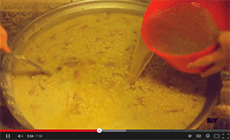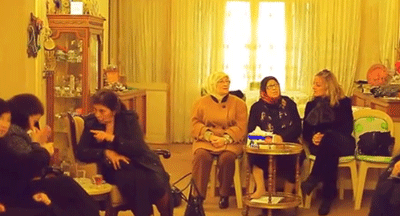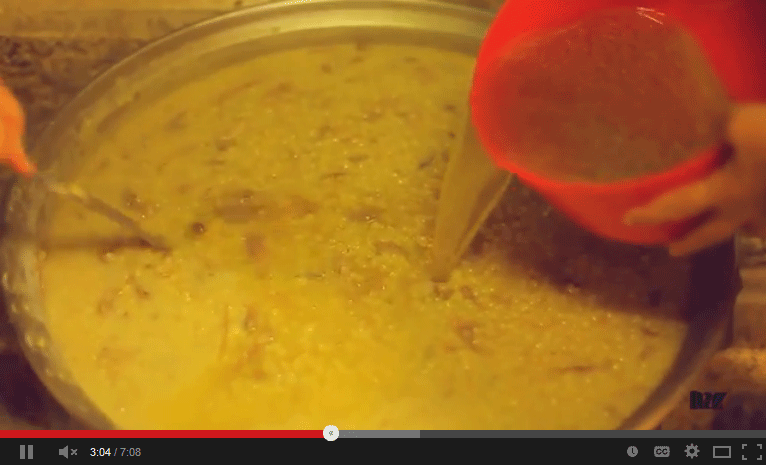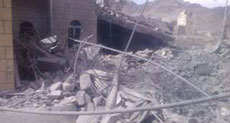
Hareeseh-Making Video ‘Salam’: A Blessing for The Soul

Nour Rida
On the annual memory of our beloved ones who had passed away, we hold prayers and read verses of the holy Quran for their dear souls. It is that, in religion and Arab culture that people honor the deceased in several ways, paying tribute to their souls and expressing love.
 In the case of Imam Hussein and his chaste household, it is not only love that people express, it also renewing the pledge to remain righteous, to stay on the correct path of Islam that Imam Hussein drew with his blood; the Islam of love and tolerance that was battled by different parties and tribes such as Yazid and the Umayyad tribe who killed Imam Hussein to pave the way for fulfilling their desires and greed.
In the case of Imam Hussein and his chaste household, it is not only love that people express, it also renewing the pledge to remain righteous, to stay on the correct path of Islam that Imam Hussein drew with his blood; the Islam of love and tolerance that was battled by different parties and tribes such as Yazid and the Umayyad tribe who killed Imam Hussein to pave the way for fulfilling their desires and greed.
Call it a stew of meat and wheat, or chicken and wheat, we call it ‘Hareeseh'. This traditional meal is prepared on several occasions, the dearest of which is the martyrdom of Imam Hussein. It is a traditional Lebanese dish made with pearled wheat and lamb or chicken, usually prepared in large quantities and shared with families.
During the days of Muharram and Ashoura, the first ten days of the first Hijri month, people usually prepare Hareeseh and organize a majlis `aza (a reception for condolences).
Why?
A flashback to Karbala to know the answer: it is the 61 AH- 680AD battle in which Imam Hussein (grandson of the Prophet Mohammed -pbuh-) was martyred along with seventy-two of his supporters and family, while his household of women and children were taken captive.
The young Islamic Republic had been divided on the question of leadership during the Ummayad caliphate. While Imam Hussein defended the lineage of the Prophet Mohammed, Yazid, the son of the ruling Caliph Muawiya, at the time wished to usurp leadership, and was in fact a corrupt leader who broke all the rules of Islam and ethics.
After Imam Hussein and his companions were martyred, the women and children were being paraded as captives through the cities. The government's purpose was to set an example to those who would dare oppose Yazid. They were meant to be a warning to others of the humiliation and punishment those who resist would have to face. But Yazid's purpose was thwarted. Sayyida Zeinab and the group of women used their trials and tribulations to awaken the Muslim community from its indifference to evil and matters of leadership.
Now back to the tradition, the food is meant as a blessing for the soul of Imam Hussein and his chaste household. Muslims ask forgiveness for Imam Hussein's death and to compensate for their own sins.
 The wheat and the chicken are cooked in 2 separate cauldrons. The women (as Hareeseh is almost exclusively prepared by women) start cooking about 12 to 14 hours before the Hareeseh can be eaten.
The wheat and the chicken are cooked in 2 separate cauldrons. The women (as Hareeseh is almost exclusively prepared by women) start cooking about 12 to 14 hours before the Hareeseh can be eaten.
First, the wheat is cooked until it becomes tender. The chicken is cooked at the same time (but only for a couple of hours) and the chicken stock is added to the wheat as the water evaporates. After around 6 hours, the wheat is soft enough to be mashed by 1 or 2 women, while the other 3 or 4 are still stirring.
The cooked chicken or meat then is added with the melted ghee and butter mixture. Some more mashing takes place, and the Hreeseh is ready to be consumed and distributed. But before that, the majlis `aza has to take place.
in remembrance of the martyrdom of Hussein and his household in Karbala,
During the reception for condolences, prayers are read and the stories of the martyrdom of Imam Hussein is recounted in chants.
For those who would like to know about this ritual, Hadi Chatila, a creative and ambitious graphic designer and filmmaker revived back a day from his video reminiscence.
He presented a short and natural documentary dubbed ‘Salam' on the very same event of the Hareeseh cooking and reception of condolences.
Hadi preferred to present the idea in a simple and creative way, sort of a cookery silent program that says it all.
 "My mom does this every year, it's a ritual she learned from her mom. The voice reciting the chants and reception is that of my late grandmother. She used to do majlis ‘aza, and these processions were recorded on a tape which my mom plays every year in Muharram," Hadi said describing the documentary.
"My mom does this every year, it's a ritual she learned from her mom. The voice reciting the chants and reception is that of my late grandmother. She used to do majlis ‘aza, and these processions were recorded on a tape which my mom plays every year in Muharram," Hadi said describing the documentary.
The 7-minute film is basically rough cuts of Hadi's annual Hareeseh family event resembled together into the final product: ‘Salam'.
"On the 11th night of Muharram, my mom prepares the Hareeseh. She stays up all night cooking it until its fully prepared and distributed the next day. She adds traditional Lebanese food to the menu, on behalf of my grandmother on such a blessed event," Hadi told our website.
On how the idea came to his mind, Hadi went on to say "I saw how my mom prepared Hareeseh every year, so I wanted to keep this memory through the documentary, to let other people know about this ritual."
Hadi, who preferred not to add effects or manipulate the original video, said he left it plain and simple so that it would reflect the event as it is, with all the natural bits and pieces, all the details.
"It was a planned idea, but a spontaneous film."
Watching the video, some friends from different cultures and religions asked the filmmaker many ‘WH questions', wanting to understand the concept clearly, or even know about something they have no idea about.
The audience Hadi targets are people who do not know about this ritual and what it runs around.
"You can say it is a teaser that opens the door for questions and answers for those who would like to know what is it all about," he explained.
Yet, Hadi noted that more important than just doing the ritual, is learning the lessons from the school of Imam Hussein, especially through the lectures given at the time Hareeseh is in its last stages and the Sheikh, or orator is reciting the procession.
To watch the documentary click on the image below:

Source: Al-Ahed News



